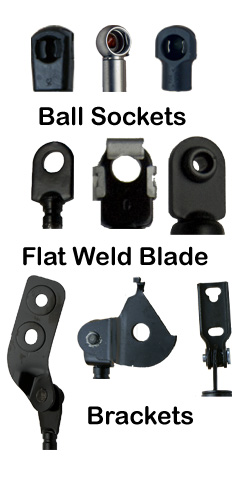Any type of connector that can be screwed or welded (Lift Supports only) to the shaft and/or body of the Lift Support or Damper should be suitable for use. When choosing a connector, the designer must take into account both tensile and compressive loading to ensure adequate strength.
The most common connector involves a ball and socket joint. While this joint style is available in many forms, they all allow rotation about the mounting point, which helps to prevent side loading on the support or damper. This is important because side loading can reduce the life of the product.
The simplest connector is a flat welded blade with a through hole. This connector has a low profile and can be very cost-effective, however, side loading can be a concern. This may be addressed by using an oversize hole, which allows for some rotation about the mounting point. Additional concerns with this connector include reduced wear and corrosion resistance.
The designer should also be concerned with the clearance around the mounting point. There should be enough room to easily mount and remove the unit from the application.

